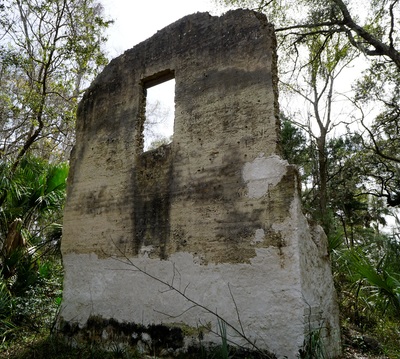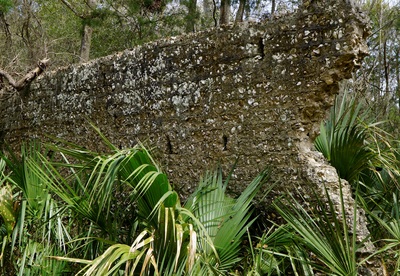Description
Two tabby walls face each other in the isolated woods of Cedar Point, located at the southern end of Black Hammock Island in the Timucuan Preserve National Park in Jacksonville, FL.
History
The tabby ruins are believed to be the remnants of the plantation established by William Fitzpatrick in 1795 on Cedar Point. In 1848 the land was sold to the Broward family, and in the 1990s it became part of the Timucuan Preserve National Park, which also includes the Thomson House and Kingsley Plantation tabby structures. (For more information see http://www.blackhammockisland.com.)
Location
Fitzpatrick Plantation proved difficult to find because the park and its website do not provide any information on the ruins. A sign at the site warns visitors away because the walls have not been stabilized, and so this may explain why no information is available. Below are details on driving to Cedar Point and walking to the ruins:
GPS: N 30°26.633 and W 81°27.700 (Cedar Point Boat Ramp Parking Lot)
N 30°26.524 and W 81°27.931 (ruins)
Address: The Cedar Point Boat Ramp parking lot is located at 9023 Cedar Point Road, Jacksonville FL 32218. Directions are given on the Timucuan Preserve website, and the location appears on the map below. At one point the road makes a sharp turn, and failing to make the turn will put the driver on a different road.
Visitors can find the start of a path at a sign at the boat ramp. Or, instead of parking at the boat ramp, visitors can follow Cedar Point Road to its very end and find the path located behind the gate, which appears to be the shorter route to the hiking trail.
Both paths converge at a sign outlining the Cedar Point hiking trails. The quickest way to the ruins is to follow the blue route (not the red) and keep left each time it forks. It is about .8 of a mile to the ruins.
Accessibility: Visitors need to be physically able to walk about two miles. Since the ruins are in a maritime forest, it is advisable to wear bug spray to ward off mosquitoes and ticks, and to wear covered shoes in case snakes or other creatures are encountered. Winter is the best time to visit.
Two tabby walls face each other in the isolated woods of Cedar Point, located at the southern end of Black Hammock Island in the Timucuan Preserve National Park in Jacksonville, FL.
History
The tabby ruins are believed to be the remnants of the plantation established by William Fitzpatrick in 1795 on Cedar Point. In 1848 the land was sold to the Broward family, and in the 1990s it became part of the Timucuan Preserve National Park, which also includes the Thomson House and Kingsley Plantation tabby structures. (For more information see http://www.blackhammockisland.com.)
Location
Fitzpatrick Plantation proved difficult to find because the park and its website do not provide any information on the ruins. A sign at the site warns visitors away because the walls have not been stabilized, and so this may explain why no information is available. Below are details on driving to Cedar Point and walking to the ruins:
GPS: N 30°26.633 and W 81°27.700 (Cedar Point Boat Ramp Parking Lot)
N 30°26.524 and W 81°27.931 (ruins)
Address: The Cedar Point Boat Ramp parking lot is located at 9023 Cedar Point Road, Jacksonville FL 32218. Directions are given on the Timucuan Preserve website, and the location appears on the map below. At one point the road makes a sharp turn, and failing to make the turn will put the driver on a different road.
Visitors can find the start of a path at a sign at the boat ramp. Or, instead of parking at the boat ramp, visitors can follow Cedar Point Road to its very end and find the path located behind the gate, which appears to be the shorter route to the hiking trail.
Both paths converge at a sign outlining the Cedar Point hiking trails. The quickest way to the ruins is to follow the blue route (not the red) and keep left each time it forks. It is about .8 of a mile to the ruins.
Accessibility: Visitors need to be physically able to walk about two miles. Since the ruins are in a maritime forest, it is advisable to wear bug spray to ward off mosquitoes and ticks, and to wear covered shoes in case snakes or other creatures are encountered. Winter is the best time to visit.



 RSS Feed
RSS Feed
